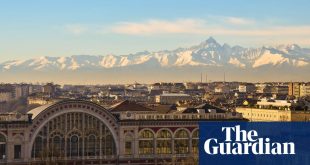On a chilly winter’s day, exactly 100 years ago, four smartly dressed men boarded a train in Edinburgh. Willie Jackson and his son Laurence were both farmers, dapper Thomas Murray bred sheep and cattle, and portly Robin Welsh was a member of Edinburgh city council. At 54, he was a little older than his pals. They had deliberated for months about whether to make their journey, but in the end went for it, and what an adventure it turned out to be.
They chugged to London, then on to Paris, before taking the 13-hour train to Chamonix. As the train wound its way through the snowy Alps, they alleviated the boredom by playing countless games of bridge. In the guard’s van were their curling stones.
Unable to farm in the winter, the men had spent hours curling on the frozen lochs of Upper Clydesdale. They became so good, they decided to enter the first ever Winter Olympics (held from 25 January to 5 February 1924).
A century on, Chamonix is as much of a draw as ever. Breathing in lungfuls of alpine air and grinning with delight as I head down the much-loved runs of Balme and Les Grands Montets, it is hard to imagine that in 1924 downhill skiing was barely a thing, and not even represented at the Olympics.
Chamonix has more than enough runs to satisfy leisurely skiers like me, but adventurers head up above the resort’s regular slopes. The original Aiguille du Midi lift carried the Olympic bobsleighs up the mountain (Great Britain took silver behind the Swiss); today its efficient replacement carries tourists and hardcore skiers from the town centre to 3,840 metres.
Still in a post après-ski stupor I forced myself onto the first lift just after 8am, the only passenger without skis, ropes and other terrifying looking high-altitude apparatus. Squeezed into the cable car, I chatted to Brit Annie-Jo Gregory. Skiing the Vallée Blanche is a rite of passage for off-piste fanatics but she was going further with a friend, climbing even higher with her skis strapped to her back before setting off downhill.
“It’s type two fun,” she grinned as the cabin swung slightly alarmingly over the town. Spotting my blank expression, she said: “It’s scary, hard work and pushes you. The fun comes afterwards when you relive it over a beer.”
The air was noticeably thinner at the summit. I gripped the handrail and wished her luck. As she headed off along a narrow ridge towards the glacier, I stuck to type one fun, taking selfies with Mont Blanc in the background and squinting down at Chamonix as if from an aircraft window.
I could just make out where the enormous 36,000 square metre Olympic ice rink would have once been. Norwegian Sonja Henie was an 11-year-old skater back then. She charmed the crowds with her infectious smile but spun out of the competition. Undeterred, she later became an Olympic champion, before moving to Hollywood and becoming a movie star.
Hidden away in the forest above the town are the remnants of the bobsleigh track, but the only completely intact structure left from the games is the Mont aux Bossons ski jump, visible from Chamonix’s ring road. It’s worth a visit to imagine the roar of the roaring-20s crowd as the athletes soared through the air.
Bespectacled, moustached and wearing a well-worn woolly hat, Henri-François Morand, president of the ski jumping section of the Club des Sports de Chamonix, proudly shows me some skis and boots from a century ago. He keeps them in the committee’s HQ, a wooden shed at the bottom of the jump. He has the air of someone who has lived a life and half in the mountains and beyond.
His ski jumping prime may be behind him but Morand talks with pride of the youngsters he’s training today.
“Isn’t it dangerous?” I ask.
“If you fall, you just slide down,” he replies with a twinkle in his eye. “I tell them, remember to breathe and we will give you some wine when you come to a stop!”
after newsletter promotion
The jump has not a speck of snow on it and Morand is convinced it’s because of climate change. He tells me about the possibility of an artificial surface being installed. “Maybe jumping can be at the summer Olympics,” he says, only half joking.
A short drive from the centre is Les Houches, a more relaxed part of “glam Cham”. Treelined and less crowded, it also has the best selection of mountain restaurants. After a morning of hard skiing I slid to a stop and ate pasta and salad at La Fre Mi, gazing over the valley.
A buzzy place to stay is the Rocky Pop, which with double rooms from £76 (breakfast is extra) is great value compared with options near the centre. The vibe is hostel meets funky hotel and is perfect for families, with attractions for children including Star Wars robots in reception.
A couple of miles up the valley is another lovely place to stay: hotel Heliopic (doubles from £150, breakfast extra), which has a pool and is more central.
After a day on the slopes I called in to the local museum, Maison de la Mémoire et du Patrimoine. Until 15 March, there’s an engaging exhibition dedicated to the Olympics, featuring grainy black and white footage. Watching the heroics and heartache of long-gone young athletes is surprisingly moving.
Afterwards it was me who struck gold, stumbling across the lively outdoor Le K bar for a bière pression followed by dinner at unfussy Italian restaurant Casa Valerio.
Under the powder blue sky the town twinkles in the sunlight, rather as it did on the opening day of the games in 1924. But earlier that January about 1.7 metres of snow fell in one 24-hour period, and hundreds of Chamonix residents with shovels joined the army to clear the stadium and the ice rink, removing snow with hand-pulled sledges just in time.
And the four Scottish curlers? Well, they ended the games triumphant, thrashing the home nation to win Gold.
With the understatement and modesty you might expect from a Scottish farmer, Thomas Murray sent a telegram home, reading simply: PLAYED TODAY. GREAT BRITAIN 46, FRANCE 4. CHAMPIONSHIP WON.
The trip was provided by the Chamonix Tourist Office. For travel to Chamonix take the Eurostar from London St Pancras to Paris. Transfer to Gare de Lyon from where it takes about six hours to reach Chamonix with up to two changes (Bellegarde-Sur-Valserine and Saint-Gervais-les-Bains)
 Top Naija News: Nigerian News, Breaking News Nigeria and World News Top Naija News is a daily news publication in Nigeria, delivering the latest breaking news in Nigeria and around the world.
Top Naija News: Nigerian News, Breaking News Nigeria and World News Top Naija News is a daily news publication in Nigeria, delivering the latest breaking news in Nigeria and around the world.



